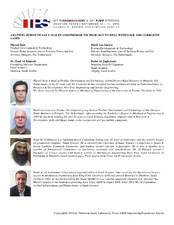| dc.description.abstract | The Oil & Gas industry faces increasing challenges to meet growing energy demands with the most sustainable exploration and production techniques. Compressor manufacturers have responded to these challenges with the development of hermetically sealed compressors, enabling gas compression with minimized environmental footprint. The main feature in all of these designs is integration of driver and driven unit into a single casing. As a result, there is no shaft protruding out of the casing, hence there is no need for shaft sealing elements like dry gas seals that have traditionally suffered poorest reliability. There is one major disadvantage of this design concept: electrical components from electrical motor and active magnetic bearings are introduced in a process gas environment. This may not be so detrimental on compressor applications handling clean, export-quality gas allowing hermetically sealed technology with the electrical insulation system directly exposed to the process gas used for cooling purposes. However, for non-clean, toxic or corrosive applications the electrical components require either special treatment or, alternatively, need to be separated from the process gas. Authors’ company has introduced the STC-ECO following the latter principle, a field-proven hermetically sealed, canned, compressor specifically designed to meet the requirements of the most demanding upstream applications. The applications have been defined and described in four distinct material categories. The primary design concept of the Electrical, Canned and Oil-free (ECO) unit is its 'canned' technology. The electric motor, Active Magnetic Bearings and instrumentation are separated from the process gas by cylindrical parts integrated in stationary housing parts, such that no electrical component is exposed to process gas. A first prototype of a canned hermetically sealed compressor has operated over 50.000 hours since installation in 2006 on a natural gas asset in the Netherlands. For more severe sour and corrosive applications, special precautions were required on the compressor package design, among which a patented hybrid rotor design and hybrid thrust disk design. The hybrid technology contains separate sections of different materials welded together to form one multi- functional solid component. Furthermore, the motor stator 'can', separating the motor stator windings from the cooling process gas, was subjected to a series of qualification tests at research institutes in the Netherlands to qualify the compatibility to H2S and corrosive conditions. For an upstream gas compression project in the Kingdom of Saudi Arabia, such a 5.8 MW unit capable of handling sour gas was designed, built and ASME PTC-10 Type-1 tested at the Author's company facility in Hengelo, The Netherlands. Upon completion of an extensive test program including emergency landing test on the auxiliary bearing system, the unit was shipped and commissioned at site in the Middle East and started operation in June 2015. The paper covers the design concept of the 'canned' hermetically sealed technology, highlights the design aspects making it suitable for sour and corrosive applications and describes the unit built and tested for the upstream gas compression project of Saudi Aramco. | en |


